


QUBIT AI – International Electronic Language Festival – Art and Technology
QUBIT AI | quantum & synthetic ai
Electronic Language International Festival
July 3rd to August 25th
Tuesday to Sunday, 10am – 8pm
FIESP Cultural Center
Design: André Lenz
Image: Iskarioto Dystopian AI Films – Athena
QUBIT AI
In its 25 years of existence, the International Electronic Language Festival (FILE) is an internationally renowned Brazilian project that since 2000 has explored the intersection between art and technology. With more than two decades of history, the festival stands out for fostering exhibition spaces and debate about artistic innovations driven by disruptive and innovative technologies, inviting the public to get involved with experimental forms of art that challenge the boundaries of conventionality. Currently, two of these technologies stand out in the contemporary scenario: the accelerated development of quantum computing and artificial intelligence corroborated by synthetic data.
Quantum computing, an emerging revolution in the technological field, offers a new range of creative possibilities for contemporary artists. This new era allows the exploration of unprecedented frontiers through a new computational format that consists mainly of quantum superposition and entanglement, a new field of exploration for synthetic computer science, as well as for the arts in general; on the other hand, artificial intelligence, fueled by synthetic data, offers artists a new way of making and understanding art, opening up space for new forms, concepts and artistic expressions.
Entitled QUBIT AI, the exhibition delves into this unexplored territory presenting a selection of works of art resulting from the connection between artistic creation and technology, proposing a theoretical reflection on what the interrelationship between quantum computers and synthetic artificial intelligence will be.
Visitors will be invited to experience immersive installations, experimental videos, digital sculptures and other forms of interactive art, which intertwine reality and imagination. The exhibition encourages reflections on the influence of technology on art and contemporary society, while at the same time providing an environment to compare already established technological arts (analog and digital) with the possible futures of art in the synthetic era, enhanced by quantum computing. The QUBIT AI exhibition at FILE SP 2024 transcends the mere presentation of works of art; it is a journey to the limits of human creativity, driven by the convergence of art, science and technology.
Ricardo Barreto and Paula Perissinotto
co-organizers and curators of FILE
International Electronic Language Festival
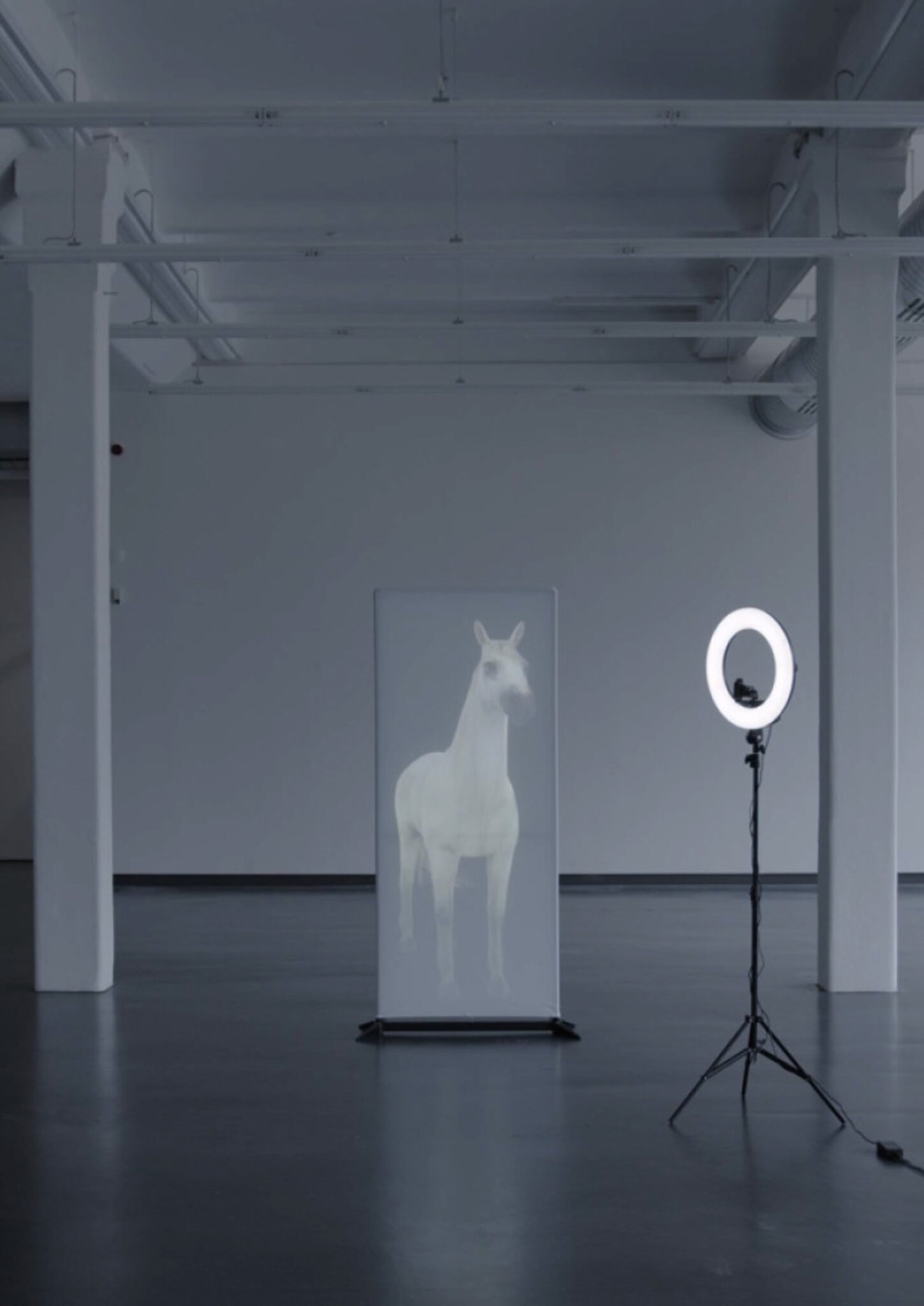
QUBIT AI: Max Haarich (Project Smart Hans)
Smart Hans
FILE 2024 | Installations
International Electronic Language Festival
Max Haarich (Project Smart Hans) – Smart Hans – Germany
The Smart Hans project is a synthetic reincarnation of Clever Hans, a horse that became famous in the early 20th century for apparently answering mathematical questions by tapping its hoof. The interactive installation features an animated horse that can guess any number in its mind through posture recognition. At the same time a fun joke and an illustration of why we worry about artificial intelligence.
Bio
Max Haarich is an artistic researcher, ethicist and consultant focusing on artificial intelligence and web3. He studied communication science at RWTH Aachen and critical thinking at the University of the Underground. After his studies, he researched artificial superintelligence at RWTH Aachen and later worked as a communications manager at Europe’s leading startup hub.
Credits
Team: Anja Borowicz Richardson (UK), Bruce Gilchrist (UK), Akshita Gupta (IND), Max Haarich (Artistic Lead/DE), Martina Huynh (NL), Asad Imtiaz (PAK), Muhammad Qasim Khan (PAK), Adrian Ludwig (DE), Pekka Ollikainen (FI), Raphael Pickl (DE).
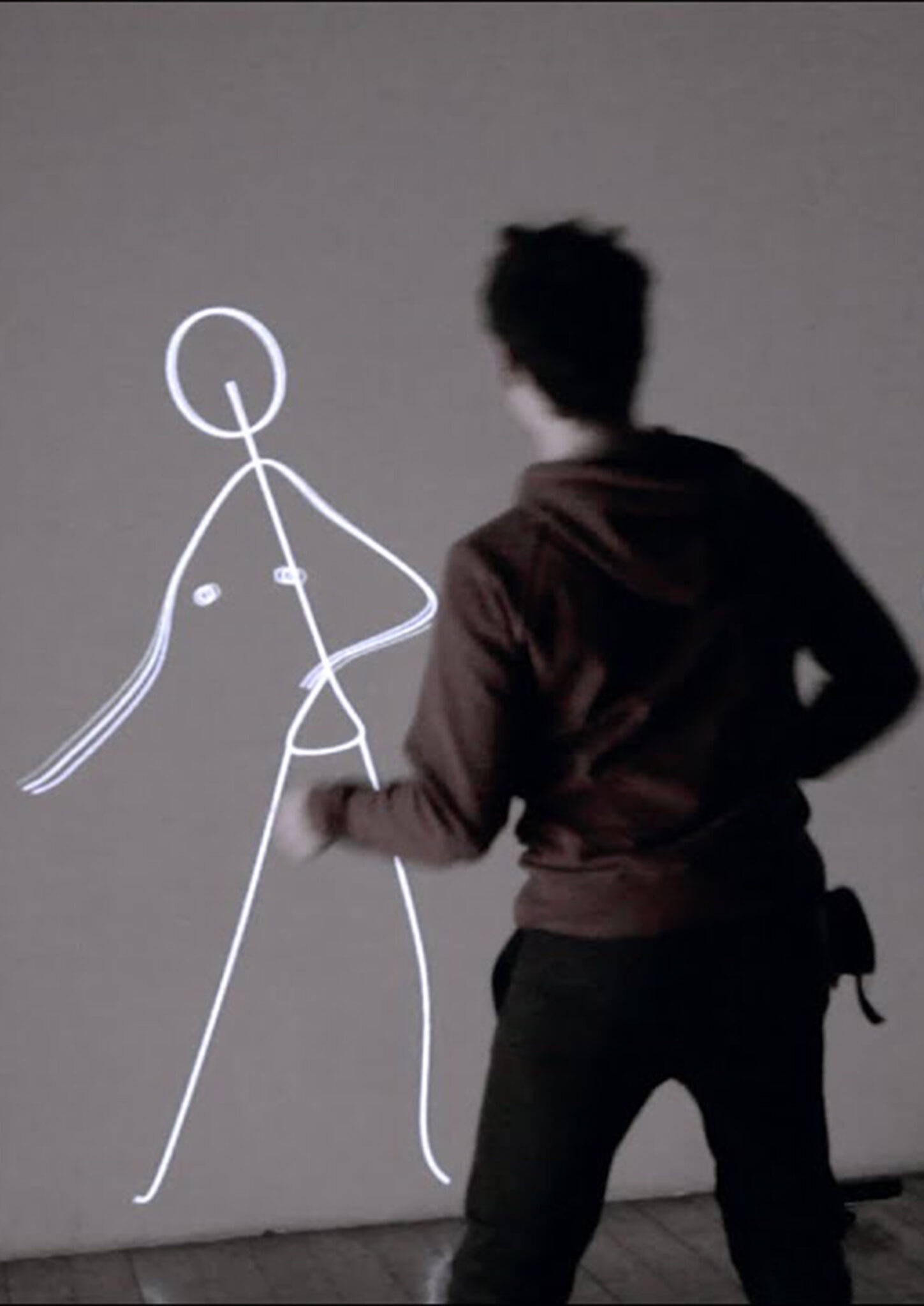
QUBIT AI: Klaus Obermaier, Stefano D’Alessio & Martina Menegon
EGO
FILE 2024 | Installations
International Electronic Language Festival
The mirror stage in psychology explains how the Ego forms through objectification, where one’s visual appearance comes into conflict with emotional experience, a concept called ‘alienation‘ by psychoanalyst Jacques Lacan. The interactive installation EGO reenacts and reverses this process by distorting the mirror image based on the user’s movements, highlighting the tension between the real and the symbolic, the Ego and the It, subject and object.
Bio
Klaus Obermaier is an interdisciplinary artist, director and composer who creates innovative works in the performing arts, music and installations using new media. Stefano D’Alessio researches social issues induced by the internet and explores how the web and its derivatives influence human behavior and the body. Martina Menegon creates intricate assemblages of physical and virtual elements, exploring the contemporary self and its hybrid corporeality.

QUBIT AI: AESTHETIC SYNTHETIC FILE – São Paulo 2024 – Art and Technology
FILE 2024
QUBIT AI | quantum & synthetic ai
Electronic Language International Festival
July 3rd to August 25th
Tuesday to Sunday, 10am – 8pm
FIESP Cultural Center
Design: André Lenz
Image: Iskarioto Dystopian AI Films – Athena
QUBIT AI
In its 25 years of existence, the International Electronic Language Festival (FILE) is an internationally renowned Brazilian project that since 2000 has explored the intersection between art and technology. With more than two decades of history, the festival stands out for fostering exhibition spaces and debate about artistic innovations driven by disruptive and innovative technologies, inviting the public to get involved with experimental forms of art that challenge the boundaries of conventionality. Currently, two of these technologies stand out in the contemporary scenario: the accelerated development of quantum computing and artificial intelligence corroborated by synthetic data.
Quantum computing, an emerging revolution in the technological field, offers a new range of creative possibilities for contemporary artists. This new era allows the exploration of unprecedented frontiers through a new computational format that consists mainly of quantum superposition and entanglement, a new field of exploration for synthetic computer science, as well as for the arts in general; on the other hand, artificial intelligence, fueled by synthetic data, offers artists a new way of making and understanding art, opening up space for new forms, concepts and artistic expressions.
Entitled QUBIT AI, the exhibition delves into this unexplored territory presenting a selection of works of art resulting from the connection between artistic creation and technology, proposing a theoretical reflection on what the interrelationship between quantum computers and synthetic artificial intelligence will be.
Visitors will be invited to experience immersive installations, experimental videos, digital sculptures and other forms of interactive art, which intertwine reality and imagination. The exhibition encourages reflections on the influence of technology on art and contemporary society, while at the same time providing an environment to compare already established technological arts (analog and digital) with the possible futures of art in the synthetic era, enhanced by quantum computing. The QUBIT AI exhibition at FILE SP 2024 transcends the mere presentation of works of art; it is a journey to the limits of human creativity, driven by the convergence of art, science and technology.
Ricardo Barreto and Paula Perissinotto
co-organizers and curators of FILE
International Electronic Language Festival

QUBIT AI: FILE QUANTUM WORKSHOP 2024 – São Paulo – Art and Technology
FILE 2024
QUBIT AI | quantum & synthetic ai
Electronic Language International Festival
July 3rd to August 25th
Tuesday to Sunday, 10am – 8pm
FIESP Cultural Center
Design: André Lenz
Image: Iskarioto Dystopian AI Films – Athena
QUBIT AI
In its 25 years of existence, the International Electronic Language Festival (FILE) is an internationally renowned Brazilian project that since 2000 has explored the intersection between art and technology. With more than two decades of history, the festival stands out for fostering exhibition spaces and debate about artistic innovations driven by disruptive and innovative technologies, inviting the public to get involved with experimental forms of art that challenge the boundaries of conventionality. Currently, two of these technologies stand out in the contemporary scenario: the accelerated development of quantum computing and artificial intelligence corroborated by synthetic data.
Quantum computing, an emerging revolution in the technological field, offers a new range of creative possibilities for contemporary artists. This new era allows the exploration of unprecedented frontiers through a new computational format that consists mainly of quantum superposition and entanglement, a new field of exploration for synthetic computer science, as well as for the arts in general; on the other hand, artificial intelligence, fueled by synthetic data, offers artists a new way of making and understanding art, opening up space for new forms, concepts and artistic expressions.
Entitled QUBIT AI, the exhibition delves into this unexplored territory presenting a selection of works of art resulting from the connection between artistic creation and technology, proposing a theoretical reflection on what the interrelationship between quantum computers and synthetic artificial intelligence will be.
Visitors will be invited to experience immersive installations, experimental videos, digital sculptures and other forms of interactive art, which intertwine reality and imagination. The exhibition encourages reflections on the influence of technology on art and contemporary society, while at the same time providing an environment to compare already established technological arts (analog and digital) with the possible futures of art in the synthetic era, enhanced by quantum computing. The QUBIT AI exhibition at FILE SP 2024 transcends the mere presentation of works of art; it is a journey to the limits of human creativity, driven by the convergence of art, science and technology.
Ricardo Barreto and Paula Perissinotto
co-organizers and curators of FILE
International Electronic Language Festival

QUBIT AI: FILE OPENING LECTURE 2024 – São Paulo – Art and Technology
FILE 2024
QUBIT AI | quantum & synthetic ai
Electronic Language International Festival
July 3rd to August 25th
Tuesday to Sunday, 10am – 8pm
FIESP Cultural Center
Design: André Lenz
Image: Iskarioto Dystopian AI Films – Athena
QUBIT AI
In its 25 years of existence, the International Electronic Language Festival (FILE) is an internationally renowned Brazilian project that since 2000 has explored the intersection between art and technology. With more than two decades of history, the festival stands out for fostering exhibition spaces and debate about artistic innovations driven by disruptive and innovative technologies, inviting the public to get involved with experimental forms of art that challenge the boundaries of conventionality. Currently, two of these technologies stand out in the contemporary scenario: the accelerated development of quantum computing and artificial intelligence corroborated by synthetic data.
Quantum computing, an emerging revolution in the technological field, offers a new range of creative possibilities for contemporary artists. This new era allows the exploration of unprecedented frontiers through a new computational format that consists mainly of quantum superposition and entanglement, a new field of exploration for synthetic computer science, as well as for the arts in general; on the other hand, artificial intelligence, fueled by synthetic data, offers artists a new way of making and understanding art, opening up space for new forms, concepts and artistic expressions.
Entitled QUBIT AI, the exhibition delves into this unexplored territory presenting a selection of works of art resulting from the connection between artistic creation and technology, proposing a theoretical reflection on what the interrelationship between quantum computers and synthetic artificial intelligence will be.
Visitors will be invited to experience immersive installations, experimental videos, digital sculptures and other forms of interactive art, which intertwine reality and imagination. The exhibition encourages reflections on the influence of technology on art and contemporary society, while at the same time providing an environment to compare already established technological arts (analog and digital) with the possible futures of art in the synthetic era, enhanced by quantum computing. The QUBIT AI exhibition at FILE SP 2024 transcends the mere presentation of works of art; it is a journey to the limits of human creativity, driven by the convergence of art, science and technology.
Ricardo Barreto and Paula Perissinotto
co-organizers and curators of FILE
International Electronic Language Festival

João Martinho Moura
WIDE/SIDE
WIDE/SIDE is an interactive installation in which shapes, images, and sounds are joined and interdependent. A visually engaging block, captivating in its monochromatic conception and minimalist lines, serves as a projection screen and teems with conglomerations of lines and shapes. As a result the installation is always changing and acquiring countless different forms.
The individual forms of the projections in reality are based on the surrounding environment, responding to the movements and gestures of the viewers. Visitors and passersby therefore themselves become part of the work and define its appearance.

Lerata and Arts Brookfield
Lumibolic
Lumibolic is an interactive and occupiable environment shaped from hyperbolic paraboloid geometries. Its luminous surfaces are composed of strands of glowing EL wire that modulate their form and intensity in response to sound and motion inputs. Designed to generate dynamic visual vibrations inspired by the work of Op-Artists Bridget Riley and Victor Vasarely, the piece visualizes relationships between site and visitor on a large scale.

Mathias Gartner & Vera Tolazzi
THE TRANSPARENCY OF RANDOMNESS
“The Transparency of Randomness” gives insight into the world of randomness. In this interactive installation, visitors can directly experience the significance of the complex interplay of randomness and stochastics in current mathematical and physical research. 27 transparent boxes, floating in space, continuously generate random numbers by using the well-known medium of the dice.The process of random number generation is influenced by the complexity of nature and its structures, using a variety of natural materials. The ensemble of all generated random numbers forms the basis of a real-time calculation and comprehensibly demonstrates the impressive role in scientific research.

Ernesto Neto and SHEN WEI DANCE ARTS
Anthropodino
Ernesto Neto’s interactive installation anthropodino, currently on display at the Park Avenue Armory, is a massive sensual playground that invites viewers to touch the various fabrics, lie down on a large purple beanbag, walk through the womb-like structure, and smell the aromatic fabric tubes dangling from above.
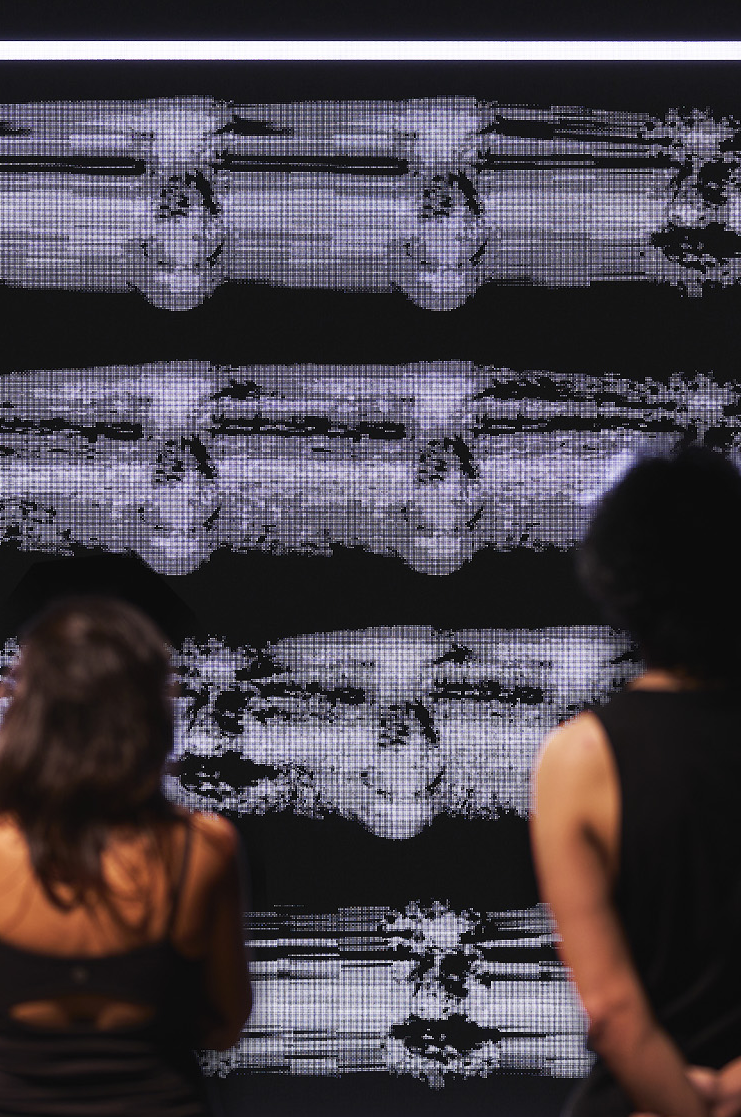
Iregular
Voices In Your Head
There is no better way to measure the influence we exert upon humans than through making them change their behaviour in real time. This is what Iregular’s digital interactive artworks are all about: they attempt to create a language so clear and so universal that it allows the communication between the interactive art piece and the human to flow intuitively every time, without any instruction in sight, as if guided by a voice running through the head.
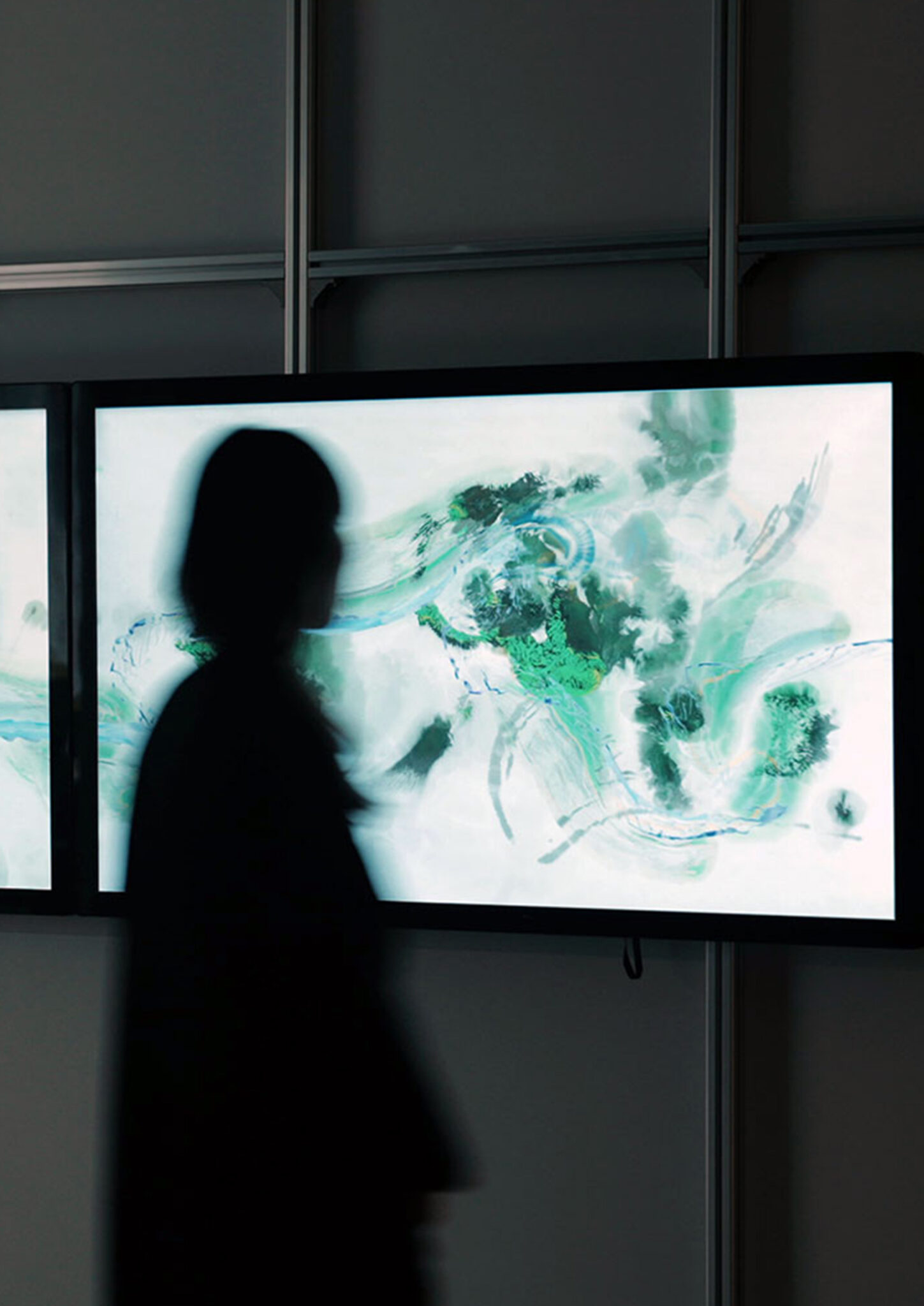
QUBIT AI: Seph Li
Everything Before, Everything After
FILE 2024 | Installations
International Electronic Language Festival
Seph Li – Everything Before, Everything After – China and UK
A digital installation features a winding river in the style of Chinese painting, symbolizing time and transition. Touch screens allow visitors to paint over it, altering its course unpredictably. The river embodies history and the future, with each trace contributing to its eternal flow through space and time. Recorded interactions ensure its perpetual existence.
Bio
Born in Beijing in 1988, Seph Li has a mixed background in technology and design, and his keen interest in interactive artworks led him to the field of media arts. Seph studied computer science and entertainment design at Tsinghua University and continued his master’s study in design/media arts at UCLA. Seph currently resides in London, United Kingdom; he creates interactive artworks as well as technical experiments with other production studios.

Hiroshi Matoba
Sun and Moon Room
Sun and Moon Room in the Art Museum of Nature and Human Non-Homogeneity, located in Bungotakada City, Oita, houses one of the interactive art installations designed to extend one’s physicality in contact with the nature. The concept of this work is a room where visitors can play with sunlight. As visitors walk through the room, small apertures on the ceiling automatically open and close, following their movements. The aperture system is designed to envelop the visitors’ bodies in light and to change the shape of the light cast at their feet, mimicking the waxing and waning of the moon. Visitors’ movements are detected by sensors, which trigger to open only the apertures located in the direction of the sun. The room is controlled to create an interior condition that represents the weather of the moment using a program for analyzing live data released by the Japan Meteorological Agency.

Ping Lim
Reimagine Social Distancing: Interactive Art for Post Pandemic Cities
Un jour dans la vie des grandes villes, des millions d’étrangers passent à quelques centimètres les uns des autres – dans les stations de métro, les trottoirs, dans les rues publiques. Nous sommes un réseau d’étrangers se déplaçant si près que cela devient parfois une expérience déshumanisée. Dans ces instants fugaces passés dans des espaces interstitiels, nous nous trouvons détachés de l’état présent où nous sommes parmi l’essaim humain. Cette installation explore comment les villes surpeuplées influencent notre sens de l’espace personnel, à travers un environnement interactif en temps réel qui suit nos données spatiales. Il examine comment nos barrières mentales sont fluides, adaptables et finalement destinées à être brisées, de sorte que notre sens de l’espace est élargi grâce à l’interaction avec les autres.

David Bowen
PLANT BOT
plant bot is a time based interactive art installation where the fates of a living plant and a computer are interdependent. Essentially the plant attempts to train a computer using image recognition. Through this process the computer will learn to recognize when the plant needs water based on images it takes of the plant. If the plant appears healthy, the computer will maintain a regular water regiment. If the plant does not appear healthy to the computer it will attempt to aid the plant by adjusting to what it “thinks” the plant needs based on the images gathered. As the computer becomes more intelligent and hence more adept at caring for the plant, the plant will conceivably thrive and grow in proportion. If the computer is unsuccessful, conceivably the opposite will occur.

NICOLAS SCHÖFFER
ニコラ·シェフェール
Chronos 5
In 1948 he created the concept of “space dynamism”. In his words, space dynamism is “the constructive and dynamic integration of space in plastic work.” Based on this idea, he will seek to create the total work of art, concretized in the cybernetic village, a city full of utopian spaces. His work combines cybernetic, kinetic art and interactive art, of which he is one of its first representatives, making the first works of art in real time or live in the history of art.

Yoon Chung Han
Eyes
Eyes is an interactive art installation and a series of biometric data artworks with my previous artwork Digiti Sonus. It’s an interactive biometric data art that transforms human’s Iris data into musical sound and 3D animated image. The idea is to allow the audience to explore their own identities through unique visual and sound generated by their iris patterns based on iris recognition and image processing techniques. As a part of the installation, selected distinctive iris images are printed in 3D sculptures, and it replays the sound generated from the iris data and projects 3D converted image images. The audience members can compare their iris-based sonic results with others, and question the “problem of disembodied identities’ in the digital era through the existence of audiovisual representations of individuals.

Lien-cheng Wan
Reading Plan
“Reading Plan is an interactive artwork with 23 automation book flipping machines. When audiences enter the exhibition room, these machines will start to turn pages automatically and read the context at the same time. The updated figure to show that average student numbers per primary school in years 2016 in Taiwan is 23 students. I included a metaphor classroom in this artwork. In Taiwan, when people go to school, they don’t have much decision power to decide what they want to read and study. It is like being controlled by a huge invisible gear. The education direction led by authorities always prioritizes industry value and competitiveness. They want create a money-making machine instead of self exploration and humanism thinking.” Lien-cheng Wan

Laura Jade
B R A I N L I G H T
“The catalyst for this research project was my flourishing intrigue and desire to harnesses my own Brain as the creator of an interactive art experience where no physical touch was required except the power of my own thoughts. To experience a unique visualisation of brain activity and to share it with others I have created a large freestanding brain sculpture that is made of laser cut Perspex hand etched with neural networks that glow when light is passed through them.” Laura Jade

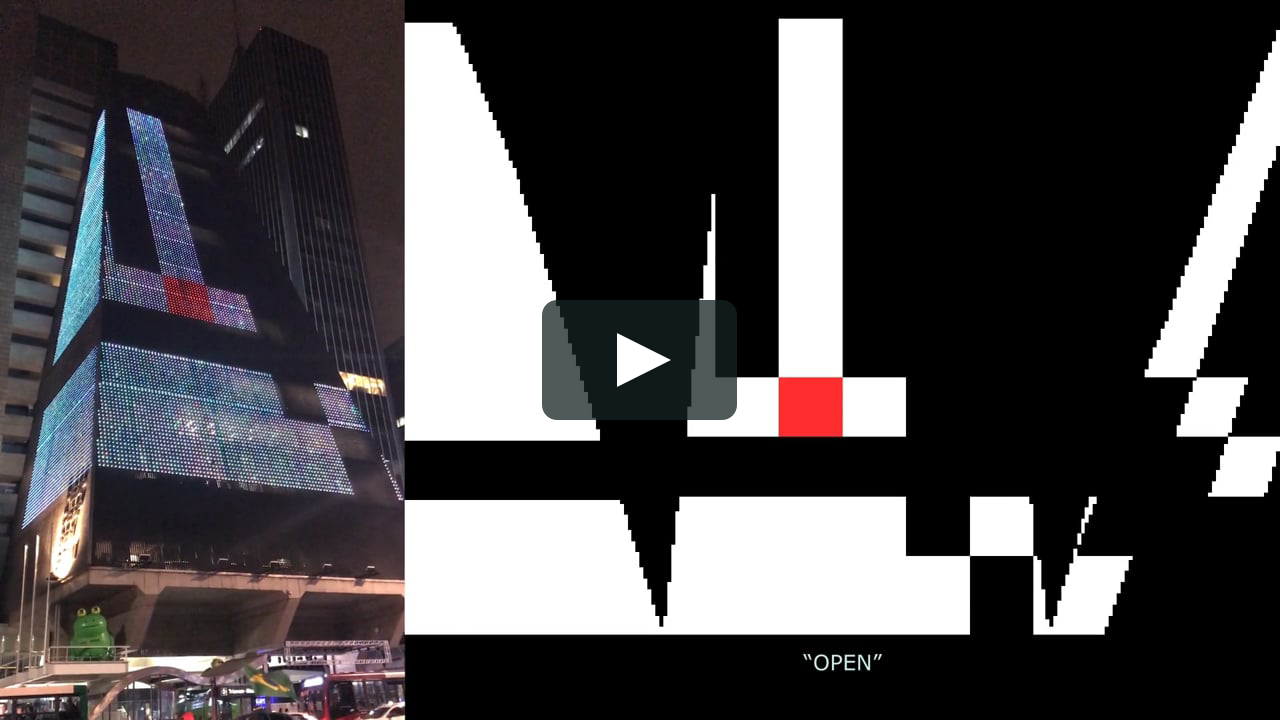
Blake Marques Carrington
The Year We Make Contact
FILE LED SHOW
FILE Festival São Paulo
Documentation of video work displayed on the 3-sided LED façade of Centro Cultural de Fiesp, in São Paulo, Brazil. The work was part of FILE Festival’s FILE LED Show 2018, on view from July 2 – August 8, 2018. The screening program featured a collaboration between FILE Festival and Pratt Institute Dept of Digital Arts in Brooklyn, led by professor Blake Marques Carrington and 13 undergraduate Interactive Arts students.

Amanita Design
Samorost 3
Prague-based Amanita Design, creators of the award-winning Mechinarium, recently released what may be their best game yet: Samorost 3. This deeply immersive puzzle game spans the ecosystems of 9 unusual planets as you encounter strange inhabitants and unlock increasingly complex secrets to advance to the next level. Amanita Design’s approach to creating completely non-verbal/non-textual games relies heavily on intuition, sound design, and symbolism to create environments that are practically interactive artworks.
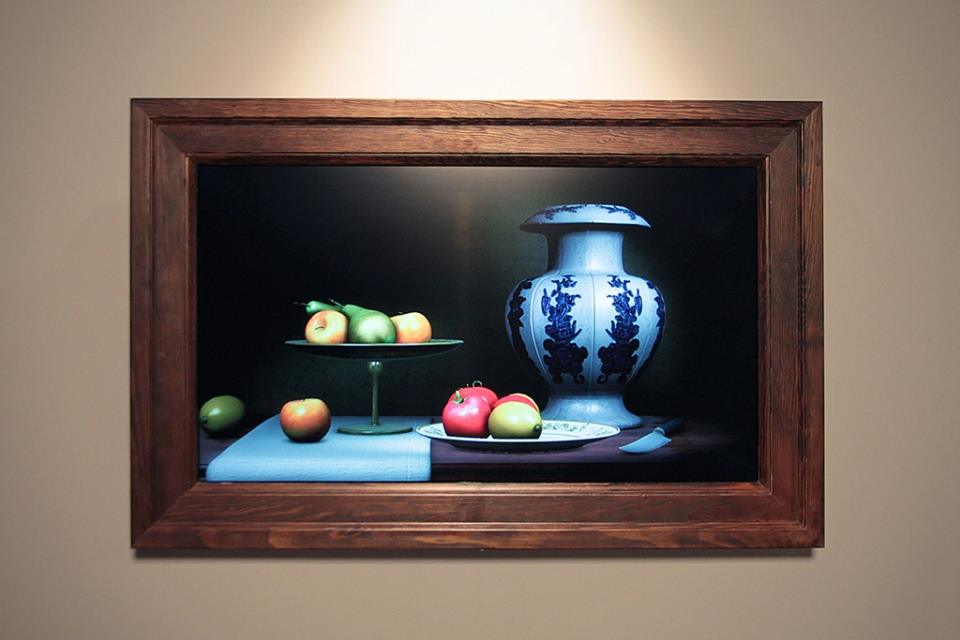
SCOTT GARNER
Still Life
Still Life is the newest release of interactive art. The project was created by the American Scott Garner and aims to enable a very different way of interacting with our staff. With it, the task of tidying up the works on the wall can become less monotonous. Garner framed an LCD screen with a rotating base, grouped a motion sensor and connected it to 3D software (which generates images in real time). The result is an interactive work of art; that simulates suffering the effects of gravity. A picture in which, in perfect synchrony, all its elements move.

MAR CANET & CARLES GUTIERREZ
videomaton
File Festival
The initial idea was to engage audiences with the classical paintings. The installation tries to transform the classical portraits into memorable and playful experiences. In short, by looking into a mirror a face of participant is captured by the system. Next, the captured face travels into one of the classical portraits. Hence, the viewer is invited into the gallery in order to recognize him or herself in one of the paintings. In other words, the art piece replaces the original painted faces by the faces of the audience. To be more specific, the authors have created an original face-morphing that integrates itself into the well-know portraits, like Meninas by Goya. To put in a nutshell, the common experience of modern art is replaced by a novel, playful and enjoyable encounter. The installation creates a framework of expression where audience spontaneously and freely interact in front of a mirror knowing that they are recorded. The results are experience by all audience in the gallery. The project was produced in 2011 as a commission of interactive art project for the new City Council of Madrid curated by Chema Conesa. “Videomaton” was presented in the opening of new City Council of Madrid located in the Cibeles square. The installation was exhibited for a year in the institution. The aim of the exhibit was displaying the famous art pieces of Madrid museums in a novel way.

BREAKFAST
Interwoven Existence
The artwork draws inspiration from the concept that individual human beings are interconnected rather than isolated. It is a visual representation of collective strength and diversity. The artwork is divided into sections of various sizes and colors, each symbolizing the diverse origins of people around the world.
As viewers approach the artwork, it becomes interactive, reflecting their image across the piece. Upon stepping away, a recording of their interaction is placed into one of the sections, symbolizing the randomness of a given person’s birthplace and socioeconomic position. Subsequently, recorded video clips of previous viewers are displayed in adjacent sections, integrating new viewers into the existing community of participants.
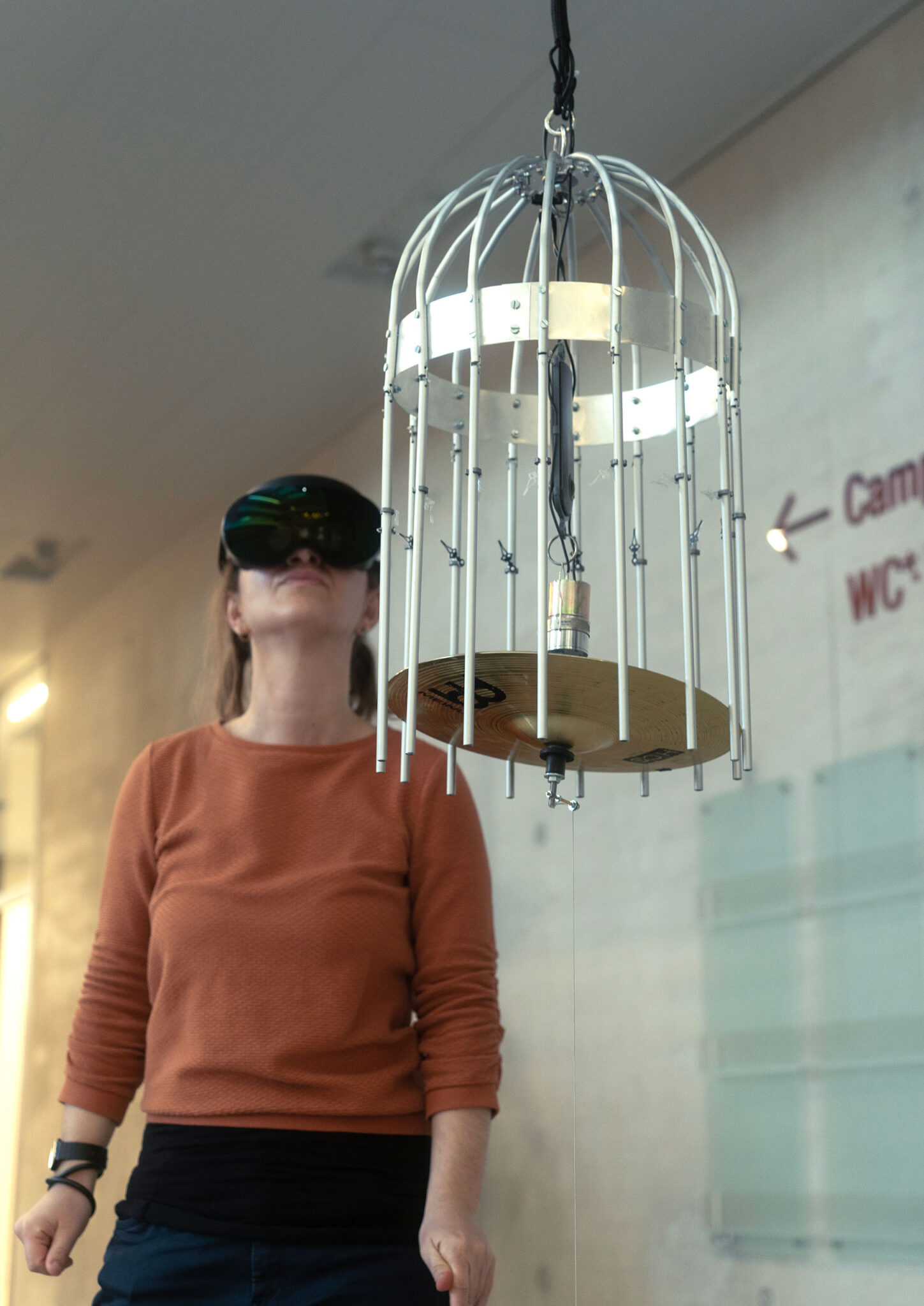
QUBIT AI: Anna Vasof & VRinMotion Team
The Cage of Time
FILE 2024 | Installations
International Electronic Language Festival
Interactive installation that presents a kinetic instrument object and virtual reality glasses, functioning as a device that animates the illusion of the passage of time in virtual space. In the fabric of existence, time weaves a cage around our ephemeral moments, limiting our perceptions of the past, present and future. By embracing this paradox, we may discover that the cage of time becomes the crucible where the alchemy of experience transforms our understanding of existence.
Bio
Anna Vasof is a multi-award-winning artist who focuses on filmmaking, short videos, and time-based sculptures. VRinMotion is an artistic research project based at St. Pölten University of Applied Sciences in Austria that investigates how features of stop-motion animation and motion capture can be combined with virtual reality to enrich current artistic discourse.
Credits
VRinMotion Team: Franziska Bruckner, Christoph Schmid, Clemens Gürtler, Matthias Husinsky, Christian Munk, Julian Salhofer, Stefan Nebel, Vrääth Öhner.
Concept by: Anna Vasof.

FILE 2024 – Call for Entries
The Call for Entries to participate in FILE – Electronic Language International Festival’s projects in 2024 is now open. The festival seeks original artworks in Art and Technology, by Brazilian and international artists. Registration remains open until February 10th. Access the registration form.
FILE is a non-profit cultural organization that has propagated creation and experimentation in Art and Technology through exhibitions, events and publications over 23 years. This call opens up the opportunity to participate in the 23rd. Edition of the Electronic Language International Festival, which is scheduled to take place at the FIESP Cultural Center, in São Paulo. The selected projects will also be able to collaborate in parallel events in different states in Brazil.
Using the registration form, it is possible to send interactive installations, sound art, video art, robotics, animations, CGI videos, virtual realities, augmented realities, mobile art, games, gifs, internet art, lectures and workshops, among others. To participate in the LED SHOW programm, exhibited annually at the FIESP Digital Art Gallery, register using the form. Sign up!

Breakfast
Portraits in Black and Silver
Portraits in Black and Silver is an interactive kinetic artwork that uses BREAKFAST’s custom-engineered Flip-Disc medium. This computer-controlled installation invites you to become a part of its history. As you engage with the piece, it will record a brief clip of your interaction and play it back at a later time, cycling through all of the portraits captured. Flip-Discs are small dime-size circles that can rotate 60 times per second using electromagnets, creating abstract images of black and silver portraits. The artwork challenges your perception of what art can be and pushes the boundaries of traditional mediums.

Bruce Nauman
Nature Morte
Nature Morte focuses on Nauman’s long relationship to his own studio, a variation on his four unique multi-projection videos, Mapping the Studio (2001). Three viewing stations, each consisting of an iPad linked to a wall-sized projection, provide an interactive exploration of the 3D studio space. Only now the artist is absent, and the participant becomes performer as he/she manipulates the large scale video projections on an iPad using touch control. The participant is free to navigate anywhere throughout the space, selecting broad vistas or individual objects. Using a hand-held 3D scanner, Nauman recorded hundreds of images that allow participants to select an object and locate close-up anything found there, and further reorient the image to see an object from above and below, and at times inside-out. The resulting mobility intensifies the experience of the viewer/performer. Presenting a static, but immersive re-creation of his studio space, Nauman’s pieces once again play at the tenuous lines between the body and space, perception and physical material.
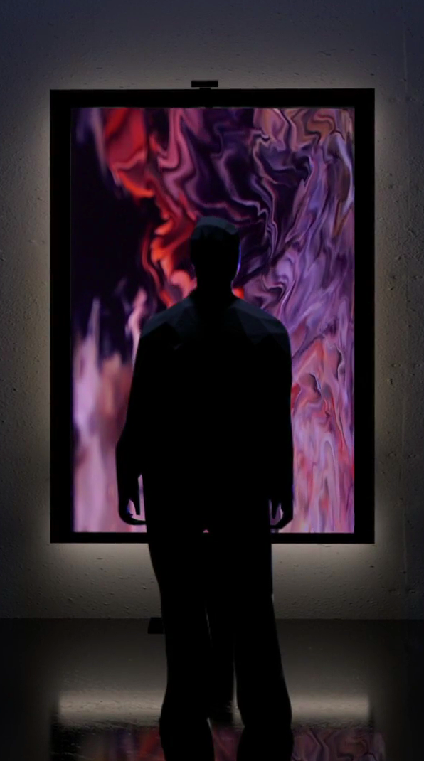
Kati Katona
Kati Katona est une artiste multimédia basée à Budapest. Son travail est axé sur la génération, animation procédurale et 3D, art de l’installation interactive, mappage de projection et conception sonore. Kati s’inspire fortement des éléments de la nature, des structures biomorphes et des algorithmes trouvés dans la nature. En tant qu’artiste visuelle, elle a participé à divers projets audiovisuels, tels que Zagar AV Experience et se concentre constamment sur l’expérience des dernières technologies.
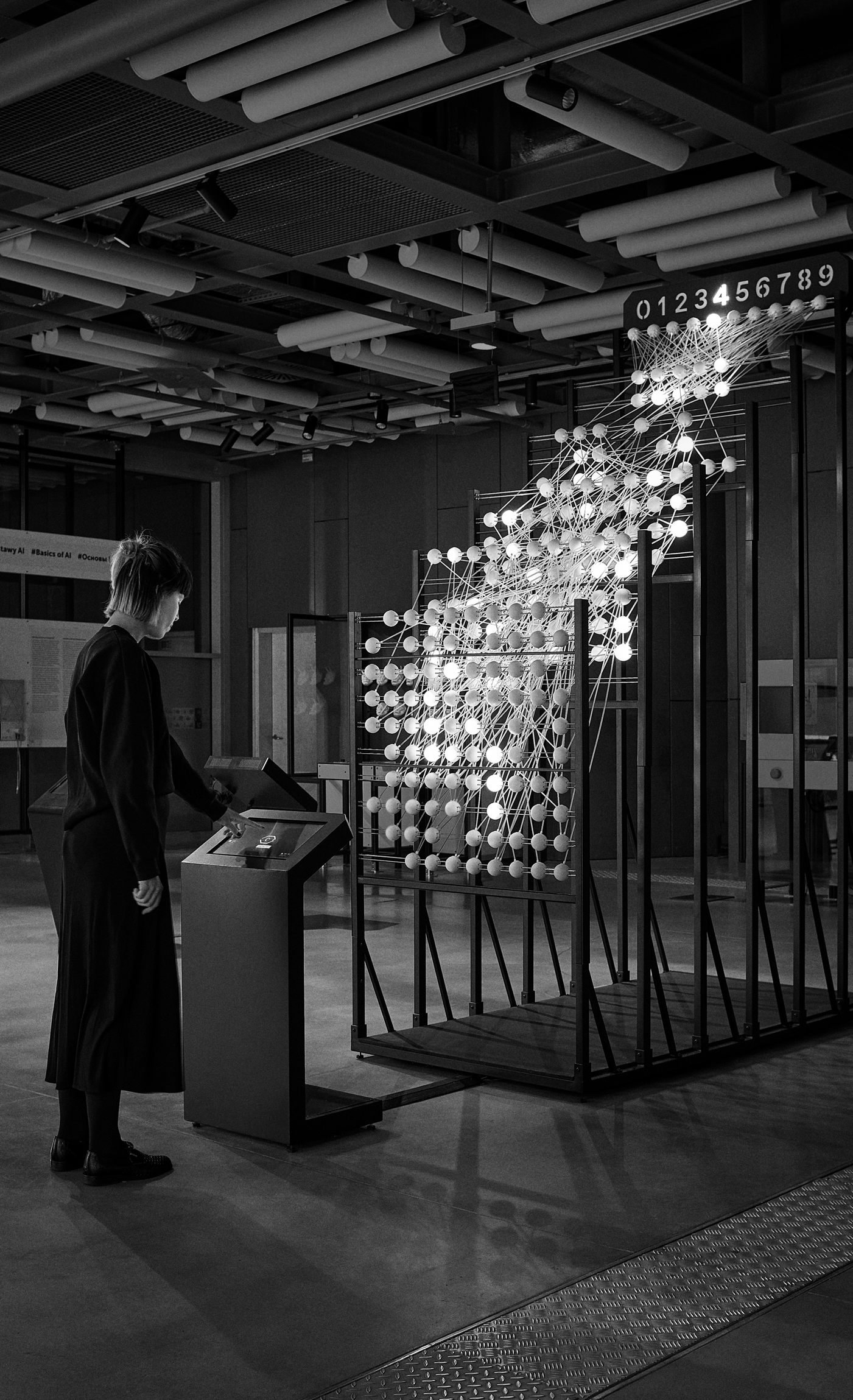
Pangenerator
The abacus
THE ABACUS is probably the first ever 1:1 interactive physical representation of real, functioning deep learning network, represented in the form of a light sculpture. The main purpose of the installation is to materialise and demystify inherently ephemeral nature of artificial neural networks on which our lives are becoming increasingly reliant on. As the part of new permanent exhibition devoted to the Future the installation aims to engage and educate the audience in artistically compelling ways being the manifestation of art and science movement goals.
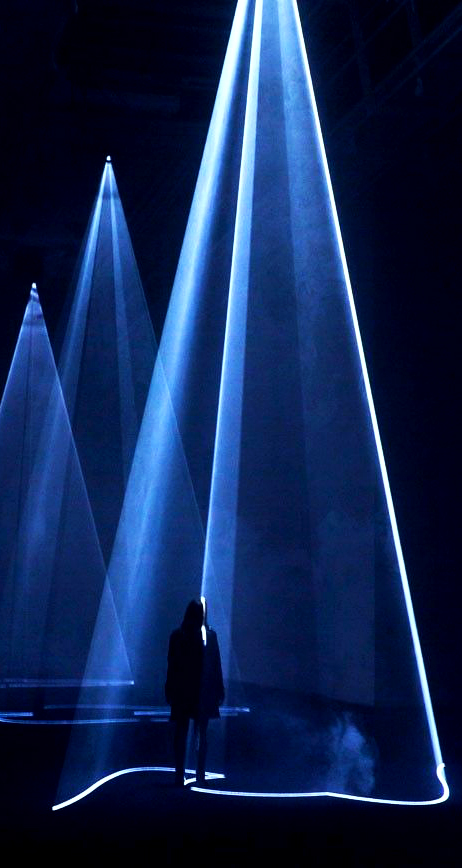
ERNESTO KLAR
Lumières relationnelles
FILE FESTIVAL
Lumières relationnelles» est une installation audiovisuelle interactive qui explore la relation des personnes avec le caractère organique-expressif de «l’espace». L’installation utilise la lumière, le son, le brouillard et un système logiciel personnalisé pour créer un espace-lumière en trois dimensions morphing (métamorphose), dans lequel les spectateurs participent activement, le manipulant avec leur présence et leurs mouvements […] un organisme vivant, avec ou sans la présence et l’interaction des spectateurs. Lorsque les spectateurs quittent la zone de suivi active, le système commence son propre dialogue avec l’espace en extrudant et en transformant des séquences de formes géométriques lumineuses. Lorsque les spectateurs pénètrent et interagissent avec l’espace-lumière projeté, une expression collective et participative de l’espace se déploie. «Relational Lights» élargit le tissu tridimensionnel de l’espace, le rendant visible, audible et tangible pour les participants.
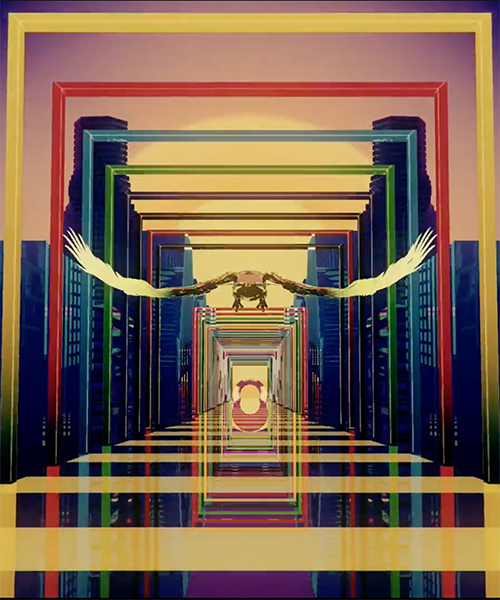
liu chang and miao jing
Hills beyond a river
Music: “CHINA-瓷” by Mickey Zhang
file festival
“Hibanana Studio is a creative art&tech studio, swinging at the intersection of audio-visual performance & installation, moving images and interactive installations. We are inventing new forms of the moving image for display surfaces of the future. A series of interdisciplinary research and practices range from video, sound, light, interaction and spatial experience leads us to artworks, commissions, and exhibition.”
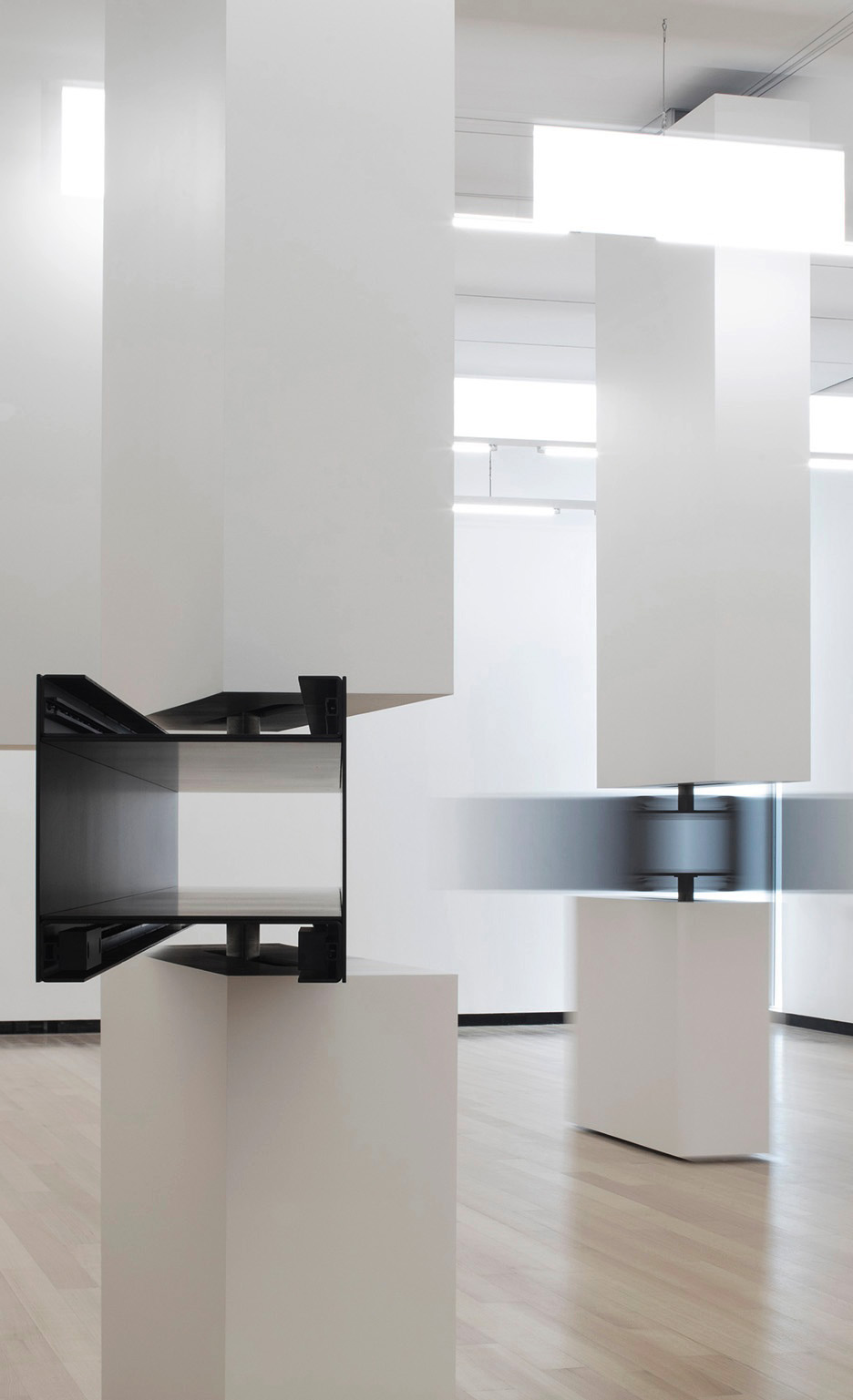
Sarah Oppenheimer
SM-4N
Sarah Oppenheimer’s work explores how individual and collective action can shape the spaces we inhabit. A master of architectural manipulations, her work is interactive, psychological, performative, and at its heart, deeply social.
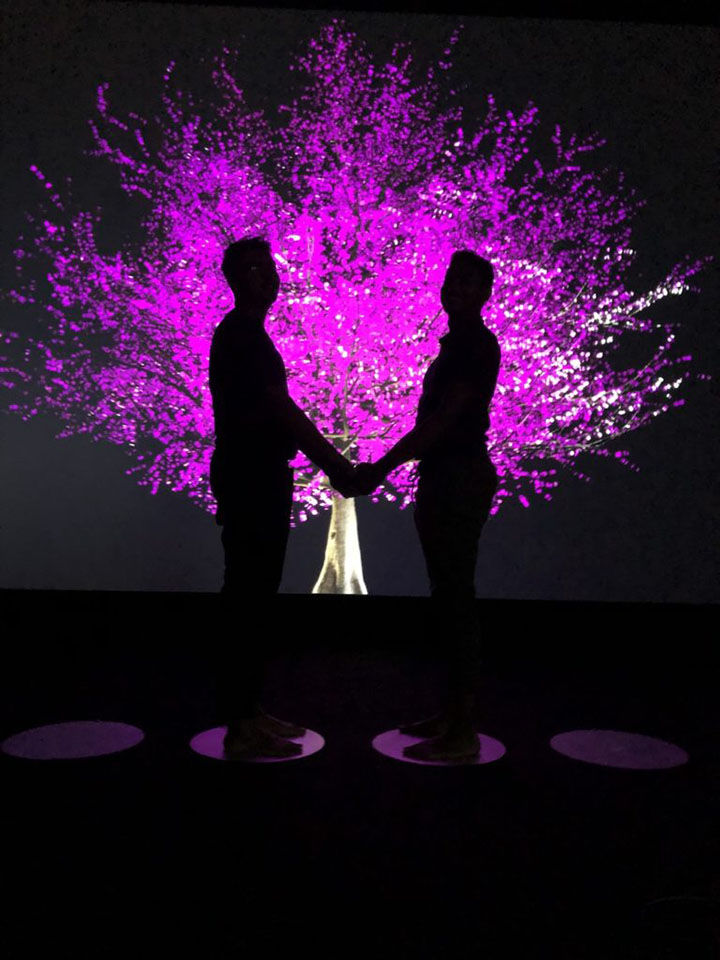
Lisa Park
Blooming
“Blooming” is an interactive audiovisual installation that highlights the importance of human connection. It takes the form of a life-size 3D Cherry blossom tree, which is a common symbol of social ties and transience of life in East Asian culture. As a response to participants’ skin-to-skin contacts, heart rate, and gestures, “Blooming” blossoms according to their intimacy. As audience members hold hands or embrace, the digital Cherry tree flowers bloom and scatter. When they let go off their physical contacts, the flower return to its pre-bloom state. The color of the flowers turns white or red based on participants’ heart rate as they interact with each other. (the faster the heart rate, the redder the tonality; the slower the heart rate, the whiter the tonality). In addition to the visual responses, sounds are also modulated according to the tree’s different stages: pre-bloom, blooming, petals falling.

Daniel Iregui
ANTIBODIES
ANTIBODIES est une installation interactive qui suit les visages des participants et les incite à faire des expressions faciales. La pièce reflète à quel point nous sommes absents et détachés lors des appels vidéo – la forme aujourd’hui imposée de rassemblements sociaux. À la fin de chaque expérience, toutes les interactions deviennent partie d’une galerie d’êtres humains désincarnés.

Studio Roosegaarde
Liquid Landscape
LIQUID LANDSCAPE is the permanent public artwork commissioned by the contemporary open air museum Arte Sella in Italy. Roosegaarde was asked to create something with a challenging framework: no use of electricity, no use of artificial light, low maintenance, robust for decades, yet interactive to people.

Simon Stimberg
Bathing Lightness
Bathing in Lightness est une installation lumineuse et sonore interactive qui semble animée par une entité essaim essayant d’explorer son monde intérieur et de communiquer avec l’extérieur. Composé de 52 ampoules à filament, il visualise le mouvement d’un essaim de particules entraîné par la présence du spectateur et sa propre envie intérieure. Les visiteurs peuvent interagir avec l’installation en se déplaçant devant elle tandis que leur mouvement est suivi par l’essaim et ainsi traduit en lumière et en son – visibles à l’intérieur du groupe d’ampoules et audibles via des haut-parleurs ou des écouteurs à proximité.

marnix de nijs
PIVOT POINT – ICHIHARA
‘Pivot Point – Ichihara’ is an interactive site-specific installation. Standing on a controller pod you navigate over and through a 3D terrain where gravity seems to have disappeared, you gradually become tele-present in a parallel projected space by exploring a mediated version of the venue, it’s direct surroundings and the Ichihara region. A cinematic journey to a fascinating point cloud realm, precise in details but simultaneously abstract and dreamlike.The kidney shaped interface is covered with capacitive sensors and mounted on a pole, touching this interface right, left, up or down aims the virtual camera accordingly. When you release the navigation pole the virtual camera automatically starts spiralling back to the initial starting point your journey and temporary centre of the universe, the Asohbara Art House.

Soft Bodies
Micro-Utopia
In response to London’s pressing housing crisis Micro-Utopia proposes a shared, immersive and interactive version of a home, where space is born from the finely-tuned sensorial interplay between the body and virtual/physical objects connected to the Internet of Things. A chair invites us to stay with it for a moment; we crawl through a demanding fireplace; our hands are washed in a bowl of digital liquid – the highly speculative model of domesticity explores the architectural implication of co-inhabiting a minimal physical infrastructure within infinitely bespoke virtual worlds. Drawing on radical art practice, interiors in historical painting and contemporary product design, Micro-Utopia is the dream of a house that is nothing, but the parameters of our perception are triggered through the metaphorical dimension of the objects we interact with on a daily basis.

Tomas SARACENO
توماس ساراسينو
托马斯·萨拉切诺
トマスサラセーノ
Space elevator / Spark
Black polyester rope, plastic cable ties, metal frame.
Having studied as an architect, Tomas Saraceno incorporates physics, engineering, and aeronautics into his interactive and evolving artistic structures. Using arachnology, or the study of spiders, to create structures that suggest alternative ways of living, he employs tridimensional webs to better understand how unique building blocks create distinct forms. Saraceno places spiders in cubic frames and leaves them to spin webs, rotating the cubes at various intervals to introduce elements of freedom

RAAAF + BARBARA VISSER
O fim do sentar
“O fim do sentar” é um modelo de pensamento da vida real que questiona nossa “sociedade sentada”. A RAAAF e a artista visual Barbara Visser desenvolveram um conceito em que a cadeira e a mesa não são mais pontos de partida inquestionáveis. Em vez disso, as várias possibilidades da instalação solicitam aos visitantes que explorem diferentes posições de pé em uma paisagem experimental. “O fim do sentar” marca o início de uma fase de teste experimental, explorando as possibilidades de mudança radical para o ambiente de vida.

Dmitry & Elena Kawarga
Down with Wrestlers with Systems and Mental Nonadapters!
file festival
“The work of Dmitry Kawarga normally deals a lot with ideas of biomorphism. A term and a small branch in art history that was very much influenced and formed by Hans Arp. Not just remaining in biomorphism, like Arp, Kawarga adds a whole new social and urban dimension to the works that make us think of terms like ”rhizome” developed by the post-structuralists Deleuze and Guattari. For Dada Moscow, Kawarga invented a totally new work, which seems to be quite different from the abstract biomorph works he normally does. It is an interactive installation that brings up a very powerful sense of the machine and technology fascination the society before the WWI had and it also shows the brutal consequence this fascination had. Kawarga creates a machine that brings the ideas of social models totally to the absurd.” Adrian Notz

Hybe
Light Tree: Interactive Dan Flavin
HYBE’s Light Tree: Interactive Dan Flavin re-illuminates the minimalist fluorescent light tubes of Dan Flavin from the 1960s, through digital technology. Experimenting with light and its effect, Flavin explored artistic meaning in relationships between light, situation, and environment. The readymade fluorescent light fixtures he used created space divided and adjusted by light and composition, offering a newly structured space with light. HYBE’s work expands the logic of Flavin by reinforcing the physical property of light through interactive media. It presents an escape from traditional lighting, as light and color changes when touched by viewers. Lighting here is divided into front and back, and colors are programmed to maintain complementary colors. The front lighting constantly interacts with colors on a back wall through visual contrast and mixture. A random change and diffusion of light with the involvement of viewers provokes tension extending and segmenting space, turning space into a forum for emotional perceptual experience.
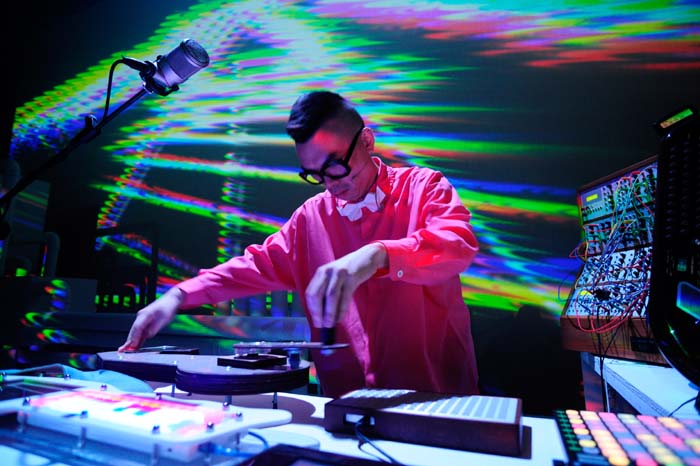
GAYBIRD
梁基爵
Digital Hug
File Festival – Hipersonica
The project is in collaboration with Henry Chu, Adrian Yeung, Thomas Ip, Joseph Chan, XEX GRP, and Hamlet Lin. It started from the fabrication of digital hubs but it turned out to make you feel like having an intimate hug, such is the chemistry coming from the new media performance “Digital Hug”. GayBird and his group of “musical frankensteins” developed a series of unconventional custom-made musical instruments and a responsive sound installation, which are played in complement to interactive video-mapping images and animation. Digital Hug emphasizes “new instruments for new music”, with the aim of bringing a unique and performative live electronic music performance to viewers.

Maurizio Bolognini
SMSMS-SMS Mediated Sublime
CIMs-Collective Intelligence Machines
“In 2000, I began to connect some of these computers to the mobile phone network (SMSMS-SMS Mediated Sublime, and CIMs-Collective Intelligence Machines). This enabled me to make interactive and multiple installations, connecting various locations.
In this case the flow of images was made visible by large-scale video-projections and the members of the audience were able to modify their characteristics in real time, by sending new inputs to the system from their own phones. This was done in a similar way to certain applications used in electronic democracy. What I had in mind was art which was generative, interactive and public.”
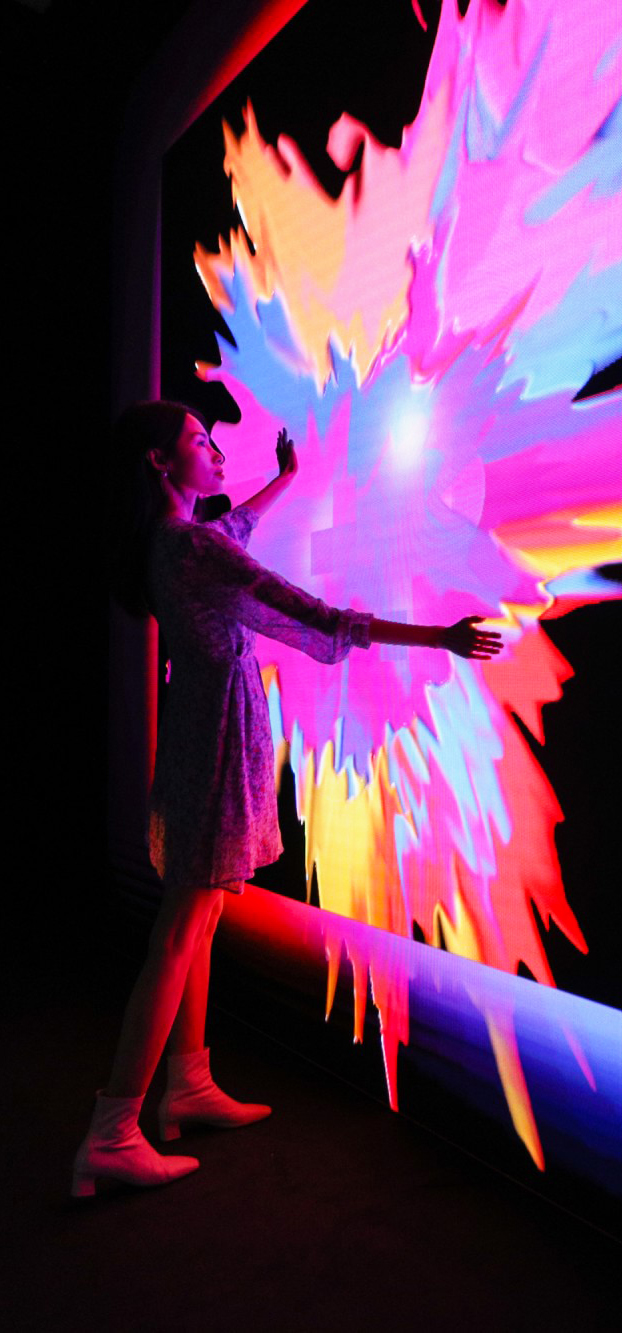
MOMENT FACTORY
Imagerie animiste
L’exposition présente aux visiteurs Duffy, l’artiste IA, avec une invitation à collaborer au sein de son studio Symbiotic. Cet espace immersif, rendu possible grâce à la projection mapping et à la technologie interactive, invite les invités à devenir l’égérie de l’IA. Alors que Duffy capture les mouvements générés par les visiteurs grâce à un suivi en temps réel, elle dessine des liens et des connexions, consultant une vaste collection de couleurs et d’images archétypales de la vie sur Terre. Le résultat est une série infinie d’œuvres d’art surprenantes – une interprétation artificielle de l’humanité et du monde naturel.

Yuri Suzuki
The welcome chorus
The Welcome Chorus is an interactive installation that brings together sound, sculpture and artificial intelligence (AI). Commissioned by Turner Contemporary for Margate NOW festival, the sculpture consists of twelve horns, each representing a different district of Kent. Each horn continually sings lyrics which are generated live by a uniquely trained, site-specific piece of AI software. Symbolically and aesthetically, these sculptural forms reference the origin of the word ‘Kent’; thought to derive from the word ‘kanto’, meaning horn or hook.

Christian Babski, Stéphane Carion, Christophe Guignar & Patrick Keller
Satellite Daylight
Satellite Daylight is an interactive light installation formed by a trapeze of 24 high-voltage neon tubes tapering upwards, created by fabric | ch – a studio for architecture, interaction and research dedicated to investigating contemporary space based in Lausanne. The installation is connected to data collected in real time from online weather stations and meteorological satellite maps, which therefore translate actual global light conditions picked up by satellites orbiting the earth at the latitude of Basel into an endless loop of perceivable electrical intensity.

